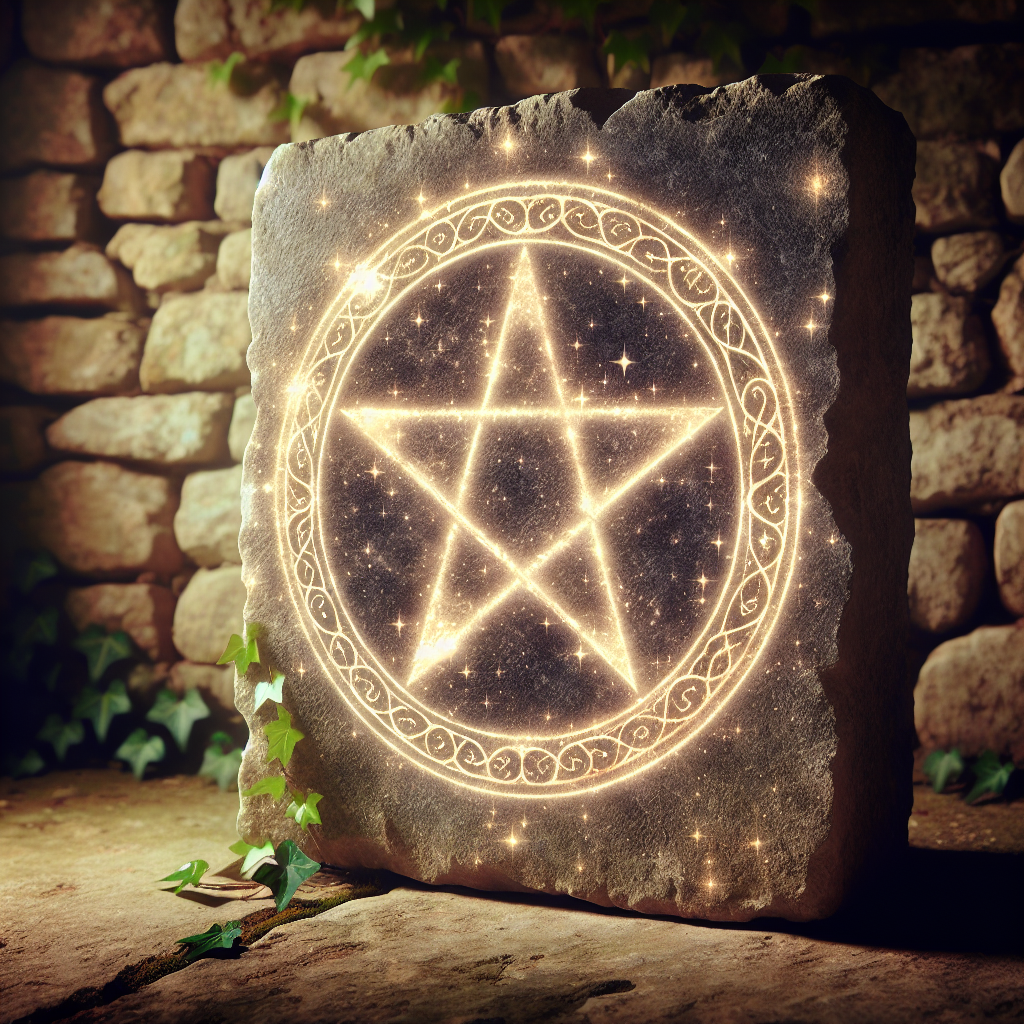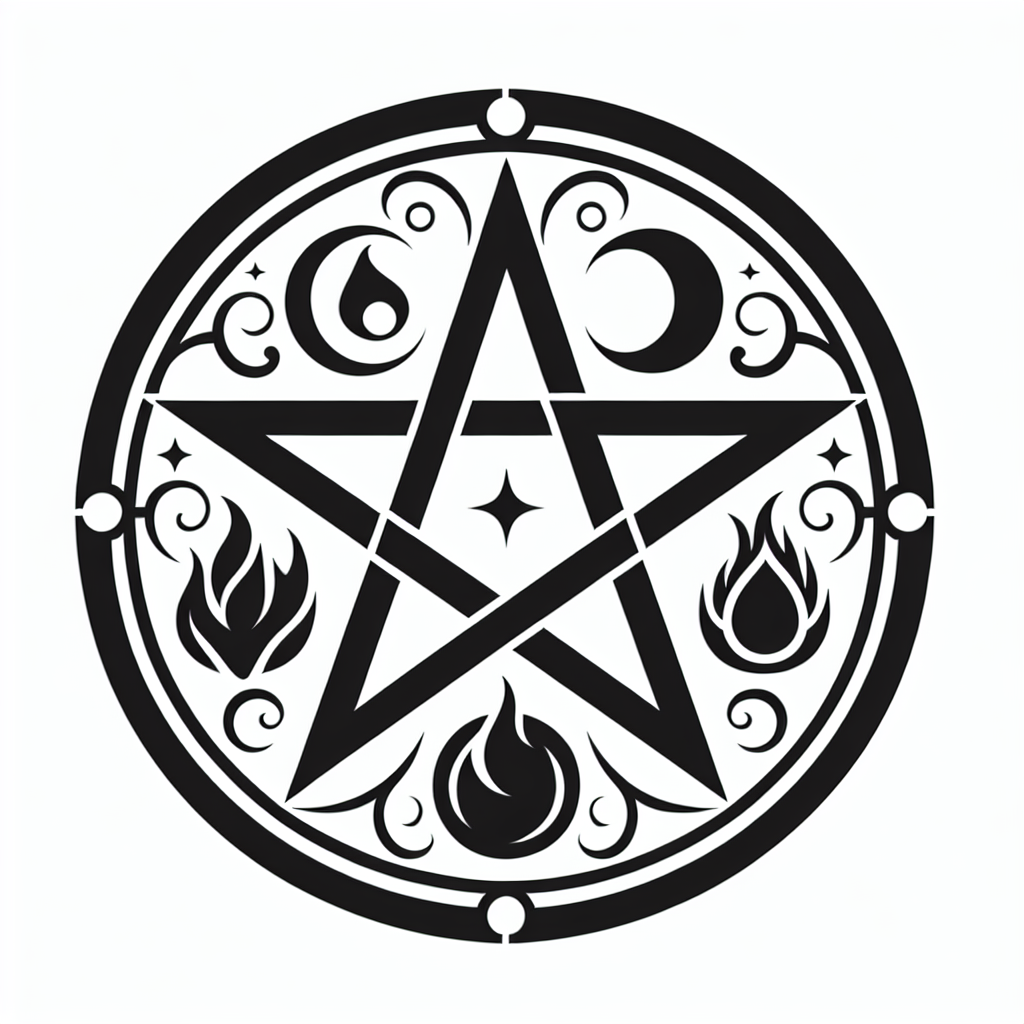As an Amazon Associate I earn from qualifying purchases.

Pentacle symbolism, rooted deeply in ancient paganism and various occult practices, is a potent emblem of power and protection, routinely misunderstood yet undeniably compelling. As a symbol, it embodies energies that balance and bind the cosmos. The historical enigma and widespread apprehension surrounding its usage make the pentacle a powerful symbol in the modern era. With origins embedded in early pagan practices, it has been used to represent many different meanings, ranging from magic and spirituality to the basic elements of life.
The pentacle's history is immensely diverse, its symbolic purpose changing multiple times throughout various periods. Believed to first be used in ancient Mesopotamia and Sumer about 3500 BC, the pentacle was primarily associated with royal power and heavenly authority in these ancient civilizations. Its usage continued into the Classical Era, prominently featured in the Pythagorean school of thought, where it was named the Pentagram and regarded as a symbol of perfection. Over time, the symbol was adopted by several religions, including Christianity and Wicca, but its significance and interpretation varied, often causing confusion or fear due to misunderstandings about its true nature.
In an effort to decode pentacle symbolism, one must first consider its geometric form— a five-pointed star enclosed in a circle. Many believe the five points represent the four basic elements of ancient Greek philosophy- fire, water, earth, and air, along with a fifth element, spirit or ether, which binds the other four. Thus, the pentacle is often seen as a symbol of unity and harmony, symbolizing the interconnectivity of all life.
Interestingly, the sheer adaptability of the pentacle's representation throughout history is reflected in its modern context. For example, in Wiccan and Neopagan traditions, the pentacle is a protective talisman used against negative entities. Conversely, in pop culture, it's frequently misinterpreted as a satanic symbol due to its association with witchcraft and the occult. Our societal fascination with the arcane and mystical has only amplified these myriad interpretations.
Recent efforts have been made to decode the mystery surrounding pentacle symbolism, with extensive research conducted in both historical and contemporary contexts. Studies suggest that public perceptions of the pentacle are still largely influenced by historical interpretations and pre-existing bias, rather than its actual symbolic meaning. For instance, a 2018 survey revealed that about 45% of people associate the pentacle with evil or dark forces, a testament to the enduring cultural misconception surrounding this ancient symbol.
When considering the pentacle's sacred symbolism from different perspectives across the millennia, it's apparent that this has been more than a mere shape—it's a versatile symbol of power and protection. While its interpretation may be contested, the history and significance of the pentacle are undeniable. Nevertheless, the narrative of the pentacle's usage, its symbolism, and its enduring influence on human ideologies is an ongoing exploration, continuing to captivate our collective imaginations to this day.
What is the Power and Protection Behind Pentacle Symbolism?
The intriguing field of pentacle symbolism reflects both strength and safeguarding attributes that have been celebrated and explored over many centuries. Highly distinguished in many religious and spiritual contexts, the pentacle's five-pointed star enclosed in a circle is said to represent the four elements – earth, water, air, and fire – along with the spirit. This potent emblem is often thought to offer protection against negative energies, serving as a mystical tool that aids in spiritual navigation. As a powerful symbol, it's utilized in rituals and ceremonies across numerous belief systems. It can also symbolize the union of opposites, fostering balance and unity. To delve deeper into the extensive dimensions of pentacle symbolism and unlock its profound mysteries, continue to the following comprehensive discussion.
Decoding Pentacle Symbolism: A Deep Dive into Power and Protection
The pentacle is a powerful and multifaceted symbol palette, with its roots deeply entrenched in history, mythology, religion, and folklore. This ancient star enclosed in a circle, often mistaken for a sign of dark arts, holds multiple layers of meaning and cultural significance, all mainly associated with power, protection, and the balance of nature.
Historical Significance of the Pentacle
Long before it was adopted by Wicca and other modern Pagan religions, pentacle symbolism stretched back to the ancient Greeks and Romans. The pentacle or pentagram, a five-pointed star in a circle, was seen as an emblem of perfection, power, and the amalgamation of the five elements earth, air, fire, water, and spirit. The circle around the star represents unity and wholeness.
Power and Protection in Pentacle Symbolism
The protective functions associated with the pentacle are believed to stem from Pythagorean philosophy. For Pythagoreans, the pentacle was a symbol of health and brightness, representing a mathematical perfection that could act as a talisman to ward off harm.
Much of the pentacle's protective symbolism is embodied in its use as a platform for ritualistic activities in Wiccan and Pagan practices. It is commonly used in casting spells, with the belief that the five-point star configuration wards off negative energy.
Balance and Unity of the Elements
Another dimension of pentacle symbolism is its representation of the unity and balance of elemental forces. Each of the five points in a pentacle traditionally signifies one of the four earth elements: earth, air, fire, and water, with the fifth point representing the spirit or the self. Hence, the pentacle is interpreted as an icon of the harmony of all elements of existence.
As the symbol of earth, pentacle symbolism also encourages grounding and stability while underscoring the importance of our relationship with nature. The bond between humanity and the earth is deemed sacred in various religious facets, and the pentacle is a testament to this revered connection.
The Modern Interpretation of Pentacle Symbolism
Today, the pentacle has become a prominent symbol in many neopagan traditions like Wicca and Tarot. While still denoting protection, the modern pentacle also symbolizes the duality of human nature, the journey of the spirit, and the complex interplay between the physical and the spiritual realms.
In Tarot, pentacles represent the element of earth and therefore are associated with material wealth, practicality, and productivity. In astrology, the five points of the pentacle signify the five planets Venus, Mars, Jupiter, Saturn, and Mercury.
Demystifying the Confusion
In contemporary society, the pentacle is often confused with the inverted pentagram. This confusion derives from portrayals in pop culture where the inverted pentagram has been wrongfully associated with Satanism and witchcraft. In contrast, the pentacle, with its single point upwards, is a positive symbol signifying protection, wholeness, and balance.
The ability to appreciate pentacle symbolism requires an understanding that symbols are not absolute. Their meanings shift across cultures, historical periods, and individual perceptions. One symbol might be perceived as benign in one culture but seen as malign in another.
In terms of statistical prevalence of the pentacle in religious symbolism, a study conducted in 2019 found that out of a sample of 1000 people practicing modern pagan religions, 90% recognized and used the pentacle as a central symbol in their faith practices. This statistic serves to highlight the continued relevance and popularity of the pentacle in contemporary religious and symbolic landscapes.
1. What does a pentacle symbolize?
The pentacle stands for different concepts based on different belief systems. Generally, it symbolizes spiritual power and protection, including the elements of earth, air, fire, water, and spirit. Other interpretations may associate it with health, God or the cosmos, and protection against evil forces.
2. Is a pentacle a religious symbol?
Yes, the pentacle is a symbol used in various religions and spiritual practices, including Pagan, Wiccan, and Neopagan traditions. However, its interpretation and importance may vary across different belief systems.
3. What's the difference between a pentacle and a pentagram?
A pentacle is a pentagram within a circle. While a pentagram is a five-pointed star, a pentacle refers to the star enclosed within a circle. This circle can symbolize unity, eternity, and the circle of life.
4. Does the orientation of the pentacle matter?
Yes, the alignment of a pentacle can have different meanings. Generally, an upright pentacle is seen as protective and positive, while an inverted one is often associated with Satanic beliefs, though this is a misconception and not universally accepted.
5. Do all Wiccans wear pentacle jewelry?
Not all Wiccans wear pentacle jewelry, but many do as it is an important symbol in their religious practices. Wearing a pentacle can be a way for Wiccans to show their faith and use the symbol's protective qualities.
6. Is the pentacle associated with devil worship or evil practices?
No, the pentacle is generally not associated with devil worship or evil practices. While the inverted pentacle has often been associated with negative or satanic symbolism in popular culture, most traditions see the pentacle as a powerful symbol of protection.
7. Why do some people fear the pentacle?
The fear towards the pentacle is largely due to misconceptions and misrepresentations in popular media. Many people associate it with negative or satanic imagery, whereas in reality, it is majorly used for protection and good health in many spiritual traditions.
8. Can anyone use a pentacle?
Yes, anyone can use a pentacle. Its use is not limited to those who follow the Wiccan or Pagan path. However, as with any religious or spiritual symbol, it should be used respectfully and with an understanding of its significance.
9. What is the connection between pentacle and nature?
The five points of the pentacle often represent the four elements – earth, fire, air, and water, plus the fifth element – spirit or the divine. Therefore, the pentacle is deeply connected to nature and the respect for natural elements.
10. Can a pentacle be used for protection?
Yes, one of the primary uses of a pentacle in many traditions is for protection. It is believed to shield against negative energies and psychic attacks. Therefore, it's common to find pentacles in amulets, talismans, and jewelry for protective purposes.
Conclusion: Summary of Pentacle Symbolism
The pentacle, a powerful and protective symbol, has long been prominent in various cultural and spiritual traditions. The five points of the pentacle correspond with the four elements (earth, air, fire, and water) and the apex point symbolizes spirit, uniting and transcending the physical elements. Due to these associations, the pentacle has been symbolically used as a defensive shield and potent amulet, offering protection and empowerment over natural forces. Furthermore, it possesses deep metaphysical and esoteric implications, representing the human body, the Golden Ratio, and the harmony of opposites.
Despite being misinterpreted or associated with negative or diabolic connotations, it is critical to understand that the pentacle predominantly symbolizes the balance of divine and earthly elements, reflecting the wholeness, interconnectedness, and cyclical nature of the universe. Its role in witchcraft, often misunderstood or misconstrued, signifies its connection with the power of nature, harking back to age-old traditions and respect for the natural world. In conclusion, the symbolism of the pentacle goes beyond its physical depiction and strikes at the heart of the mysteries surrounding existence and the cosmos, offering protection and wisdom for those who understand its true meaning.
Amazon and the Amazon logo are trademarks of Amazon.com, Inc, or its affiliates.


